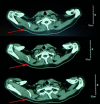Unusual insidious spinal accessory nerve palsy: a case report
- PMID: 20507553
- PMCID: PMC2890620
- DOI: 10.1186/1752-1947-4-158
Unusual insidious spinal accessory nerve palsy: a case report
Abstract
Introduction: Isolated spinal accessory nerve dysfunction has a major detrimental impact on the functional performance of the shoulder girdle, and is a well-documented complication of surgical procedures in the posterior triangle of the neck. To the best of our knowledge, the natural course and the most effective way of handling spontaneous spinal accessory nerve palsy has been described in only a few instances in the literature.
Case presentation: We report the case of a 36-year-old Caucasian, Greek man with spontaneous unilateral trapezius palsy with an insidious course. To the best of our knowledge, few such cases have been documented in the literature. The unusual clinical presentation and functional performance mismatch with the imaging findings were also observed. Our patient showed a deterioration that was different from the usual course of this pathology, with an early onset of irreversible trapezius muscle dysfunction two months after the first clinical signs started to manifest. A surgical reconstruction was proposed as the most efficient treatment, but our patient declined this. Although he failed to recover fully after conservative treatment for eight months, he regained moderate function and is currently virtually pain-free.
Conclusion: Clinicians have to be aware that due to anatomical variation and the potential for compensation by the levator scapulae, the clinical consequences of any injury to the spinal accessory nerve may vary.
Figures




References
-
- Teboul F, Bizot P, Kakkar R, Sedel L. Surgical management of trapezius palsy. J Bone Joint Surg Am. 2004;86A(9):1884–1890. - PubMed
-
- Bigliani LU, Perez-Sanz JR, Wolfe IN. Treatment of trapezius paralysis. J Bone Joint Surg Am. 1985;67A:871–877. - PubMed
-
- Fiddian NJ, King RJ. The winged scapula. Clin Orthop. 1984;185:228–236. - PubMed
LinkOut - more resources
Full Text Sources

